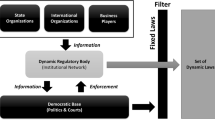Abstract
Like most criminological research, much of the research on hacking has predominantly focused upon the Northern Metropolis. As a result, there is a lack of focus on cybercrime within the Global South, particularly on illegal intrusions into computer systems, more colloquially known as hacking. This article provides a critical overview of hacking in the Global South, highlighting the role of strain in this offending behaviour. In particular, the authors note the role of Australian, American, and Taiwanese immigration policies that act to block offenders’ transitions from illicit hacking to legitimate employment in technological hubs outside of the Global South. To address these blocked opportunities, this article suggests the use of innovative justice paradigms, particularly restorative justice and regulatory self-enforcement, that respond to innovation-based cybercrime while also facilitating offender movement into “white hat” employment, even in cases of technology-facilitated sexual violence.
Similar content being viewed by others
Availability of Data and Material
Not applicable.
Code Availability
Not applicable.
Notes
See Das (2011) for a discussion of this in an American context.
To simplify the discussion, any use of the terminology “shame” throughout this article will refer to reintegrative shaming, unless specifically noted as stigmatising/disintegrative shame.
See Bisson (2018) for an example of this related to Tesla cars.
The authors acknowledge this title/terminology refers to an episode of sexual violence against many celebrities. However, this appears the colloquial term for the event.
The authors make a note to delineate gendered and sexual violence offences. While these terms are often combined and used interchangeably, we note that sexual violence offences can occur across the gender spectrum and have diverse motivations.
The use of restorative justice for gendered and sexual offences is still under debate. The above concerns represent a snapshot of the wider critiques of utilising restorative justice for these offences. For more information on this debate and further concerns, see e.g. Daly (2008) and Mercer & Sten Madesen (2015).
The authors note that the Internet can provide an outlet for feminist discourse. However, as noted by Sculos (2017: 5) “mass media, Internet culture, and yes, even children’s movies occasionally that aid in the reproduction of a toxically masculine capitalist society”.
For further evidence of this in relation to Pornhub.com and problematic sexual content see BBC (2020).
References
Alienth [pseudonym]. (2015). Time to Talk. Available at: https://www.reddit.com/r/announcements/comments/2fpdax/time_to_talk/.
Ayres, I., & Braithwaite, J. (1992). Responsive regulation: Transcending the deregulation debate. Oxford University Press.
BBC. (2020). Pornhub removes all user-uploaded videos amid legality row. BBC, 14 december 2020. Retrieved 10 August 2021, from:https://www.bbc.com/news/technology-55304115.
Bisson, D. (2018). Tesla encouraging “Good Faith” security research in bug bounty program. Available at: https://www.tripwire.com/state-of-security/security-data-protection/tesla-encouraging-good-faith-security-research-in-bug-bounty-program/.
Braithwaite, J. (1982). Enforced self-regulation: A new strategy for corporate crime control. Michigan Law Review, 80, 1466–1507.
Braithwaite, J. (1989). Crime, shame and reintegration. Cambridge University Press.
Chang, L. Y. C. (2012). Cybercrime in the Greater China Region: Regulatory response and crime prevention across the Taiwan Strait. Edward Elgar.
Chang, L. Y. C., & Poon, R. (2017). Internet vigilantism: Attitudes and experiences of university students in Hong Kong. International Journal of Offender Therapy and Comparative Criminology, 61(16), 1912–1932.
Chang, L. Y. C., Zhong, Y., & Grabosky, P. (2018). Citizen co-production of cyber security: Self-help, vigilantes, and cybercrime. Regulation & Governance, 12(1), 101–114.
Chang, L. Y. C., Mukherjee, S., & Coppel, N. (2021). We are all victims: Questionable content and collective victimisation in the digital age. Asian Journal of Criminology, l, 16, 37–50.
Daly, K. (2000). Revisiting the relationship between retributive and restorative justice. In H. Strang & J. Braithwaite (Eds.), Restorative justice: Philosophy to practice (pp. 33–54). Routledge.
Daly, K. (2008). Setting the record straight and a call for radical change: A reply to Annie Cossins on ‘Restorative justice and child sex offences.’ The British Journal of Criminology, 48(4), 557–566.
Daly, K. (2017). Restorative justice: The real story. Punishment & Society, 4(1), 55–79.
Das, A. (2011). The immigration penalties of criminal convictions: Resurrecting categorical analysis in immigration law. New York University Law Review, 86(6), 1669–1760.
Dupont, B., Côté, A. M., Savine, C., et al. (2016). The ecology of trust among hackers. Global Crime, 17(2), 129–151.
Durkheim, E. (1968). Suicide: A study in sociology. Routledge & Kegan Paul Ltd.
Grabosky, P. (1995). Regulation by reward: On the use of incentives as regulatory instruments. Law and Policy, 17(3), 257–282.
Gunningham, N., & Grabosky, P. (1998). Smart regulation: Designing environment policy. Oxford Unievrsity Press.
HackerOne. (2019). The 2019 Hacker Report. Retrieved 10 August 2021, from: https://www.hackerone.com/sites/default/files/2019-03/the-2019-hacker-report_0.pdf.
HackerOne. (n.d.). Vulnerability disclosure guidelines. Retrieved 10 August 2021, from: https://www.hackerone.com/disclosure-guidelines.
Henry, N., & Powell, A. (2015). Embodied harms: Gender, shame, and technology-facilitated sexual violence. Violence against Women, 21(6), 758–779.
Hickson, L. (1975), The Isoro: Social and Psychological Factors of Dispute Settlement and Punishment Avoidance in Fiji, Doctoral Thesis, Harvard University.
Huang, H. F., & Chang, L. Y. C. (2013). Evaluating restorative justice programs in Taiwan. Asian Journal of Criminology, 8(4), 297–307.
Johnstone, G. (2017). Restorative justice for victims: Inherent limits? Restorative Justice, 5(3), 382–395.
Kao, D.-Y., Huang, F., & Wang, S. J. (2009). Persistence and desistance: Examining the impact of re-integrative shaming to ethics in Taiwan juvenile hackers. Computer Law & Security Review, 25(5), 464–476.
Katz, I. (2016). Hacking: Truth or treason. Retrieved 10 August 2021, from: https://www.bbc.com/news/world-us-canada-38303381.
Kleijssen, J., & Perri, P. (2017). Cybercrime, evidence and territoriality: Issues and options. Netherlands Yearbook of International Law, 2016, 147–173.
Krone, T. (2005). Hacking offences. High tech crime brief 5. Austrlalian Institute of Criminology.
Lagnese, N., Henning, L., Brown, E. & Kimball, T. (2018). Lizard squad. Retrieved 10 August 2021, from: https://www.saintleo.edu/hubfs/Resource%20PDFs%20and%20DOCs/Academics/Center%20for%20Cybersecurity/Student%20Projects/2018/Lizard%20Squad.pdf.
Liu, J., Travers, M., & Chang, L. (Eds.). (2017). Comparative criminology in Asia (pp. 135–148). Springer.
Lusthaus, J. (2018). Industry of anonymity. Harvard University Press.
Madarie, R. (2017). Hackers’ motivations: Testing Schwartz’s theory of motivational types of values in a sample of hackers. International Journal of Cyber Criminology, 11(1), 78–97.
Marsh, F., & Wager, N. M. (2015). Restorative justice in cases of sexual violence: Exploring the views of the public and survivors. Probation Journal, 62(4), 336–356.
Marwick, A. E. (2017) Scandal or sex crime? Gendered privacy and the celebrity nude photo leaks. Ethics and Information Technology, 19(3), 177-191.
Mercer, V. & Sten Madesen, K. (2015). Doing restorative justice in cases of sexual violence: A practice guide. Avialable at: https://www.law.kuleuven.be/linc/english/research/RJ_sexual_violence_practice_guide_Sept2015.pdf.
Merton, R. K., & Rossie, A. S. (1968). Social theory and social structure. Alexander Street Press.
Merry, S. E. (2006), Human Rights & Gender Violence: Translating International Law Into Local Justice, The University of Chicago Press, London.
Mützel, D. (2019). Meet the hacker who busts child pornographers on the dark net. Retrieved 10 August 2021, from:https://www.vice.com/en_au/article/ywbmyb/meet-the-hacker-who-busts-child-pornographers-on-the-dark-net.
Radu, A. -I., Thomas, S. L. (2015). Organising monkeys or how to run a hacking club. Workshop on Cybersecurity Training & Education (VIBRANT15), 4.
Raharjo, A., & Sudrajat, T. (2018). Legal protection for cyber crime victims on victimological perspective. SHS Web of Conferences, 54, 08004.
Schrock, A. R. (2016). Civic hacking as data activism and advocacy: A history from publicity to open government data. New Media & Society, 18(4), 581–599.
Sculos, B. W. (2017). Who’s afraid of ‘toxic masculinity.’ Class, Race and Corporate Power, 5(3), 1–5.
Senarathna, I. & Warren, M. (2017). A Sri Lankan hacking case study. In: Valli, C. (eds) The Proceedings of 15th Australian Information Security Management Conference, 5–6 December, 2017 (pp. 64–69). Edith Cowan University.
Shapland, J., Atkinson, A., Atkinson, H., Colledge, E., et al. (2006). Situating restorative justice within criminal justice. Theoretical Criminology, 10(4), 505–532.
Suzuki, M., Pai, C. F., & Islam, Md. (2018). Systematic quantitative literature review on criminological theories in Asia. Asian Journal of Criminology, 13, 129–151.
Stalans, L. J. & Donner, C. M. (2018). Explaining why cybercrime occurs: Criminological and psychological theories. In: Jahankhani H (eds) Cyber Criminology (pp. 25–45). Springer Nature.
Strang, H., & Braithwaite, J. (2017). Restorative justice: Philosophy to practice. Routledge.
US Department of Justice. (2021). Four Chinese nationals working with the Ministry of State Security charged with global computer intrusion campaign targeting intellectual property and confidential business information, including infectious disease research. Retrieved 10 August 2021, from: https://www.justice.gov/opa/pr/four-chinese-nationals-working-ministry-state-security-charged-global-computer-intrusion.
Wall, D. S. (2008). Cybercrime, media and insecurity: The shaping of public perceptions of cybercrime. International Review of Law, Computers & Technology, 22(1–2), 45–63.
Webber, C., & Yip, M. (2018). The rise of Chinese cyberwarriors: Towards a theoretical model of online hacktivism. International Journal of Cyber Criminology, 12(1), 223–247.
Yafi, E., Yefimova, K. & Fisher, K. (2018). Young hackers: Hacking technology at Za’atari Syrian Refugee Camp. CHI Conference on Human Factors in Computing Systems, 21–26, April, 2018.
Zehr, H. (2015). The little book of restorative justice: Revised and updated. Retrieved 10 August 2021, from: https://www.simonandschuster.com/books/The-Little-Book-of-Restorative-Justice/Howard-Zehr/9781561488230.
Author information
Authors and Affiliations
Corresponding author
Ethics declarations
Human and Animal Rights
No ethics review is needed as this research involves no humans and animals.
Conflict of Interest
The authors declare no competing interests.
Additional information
Publisher’s Note
Springer Nature remains neutral with regard to jurisdictional claims in published maps and institutional affiliations.
Rights and permissions
About this article
Cite this article
Chang, L.YC., Whitehead, J. What the Hack: Reconsidering Responses to Hacking. Asian J Criminol 17, 113–126 (2022). https://doi.org/10.1007/s11417-021-09356-1
Received:
Accepted:
Published:
Issue Date:
DOI: https://doi.org/10.1007/s11417-021-09356-1




